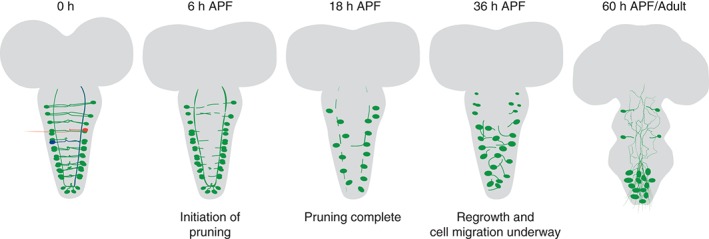Figure 3.

Remodeling of CCAP/Bursicon neurons during metamorphosis: in the larval and prepupal stage, CCAP expressing neurons line the entire ventral nerve cord (VNC) and form an intricate network. There are two major types of neurons, efferent neurons, and interneurons. Efferent neurons (one example highlighted in red) send projections from the cell bodies, that are located on both sides of the VNC, cross to the midline where they then exit the VNC through the dorsal part of the VNC. The neurites of the interneurons (one example highlighted in blue) cross the midline and then bifurcate to send projections to both the anterior and posterior areas of contralateral side of the VNC. At 6 h APF pruning begins with the neurites in the center of the VNC disappearing first followed by the longitudinal tracts. At the onset of regrowth (36 APF), cell somas are also beginning to migrate to the abdominal area of the VNC. At the adult stage, cell somas are up to twice the size of larval somas and they send projections through the adult VNC. By 60 h APF, the CCAP neurons have acquired their final adult connectivity with the unipolar neurons sending their dendrites up along the VNC while their axons enter the VNC at the midline and exit from the ventral side of the VNC to innervate their targets. Labels are major time occurances of processes. For more detailed time analysis, see Figure 4 (based on Refs 25 and 26).
